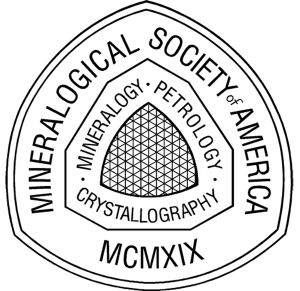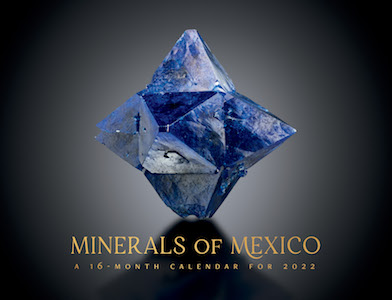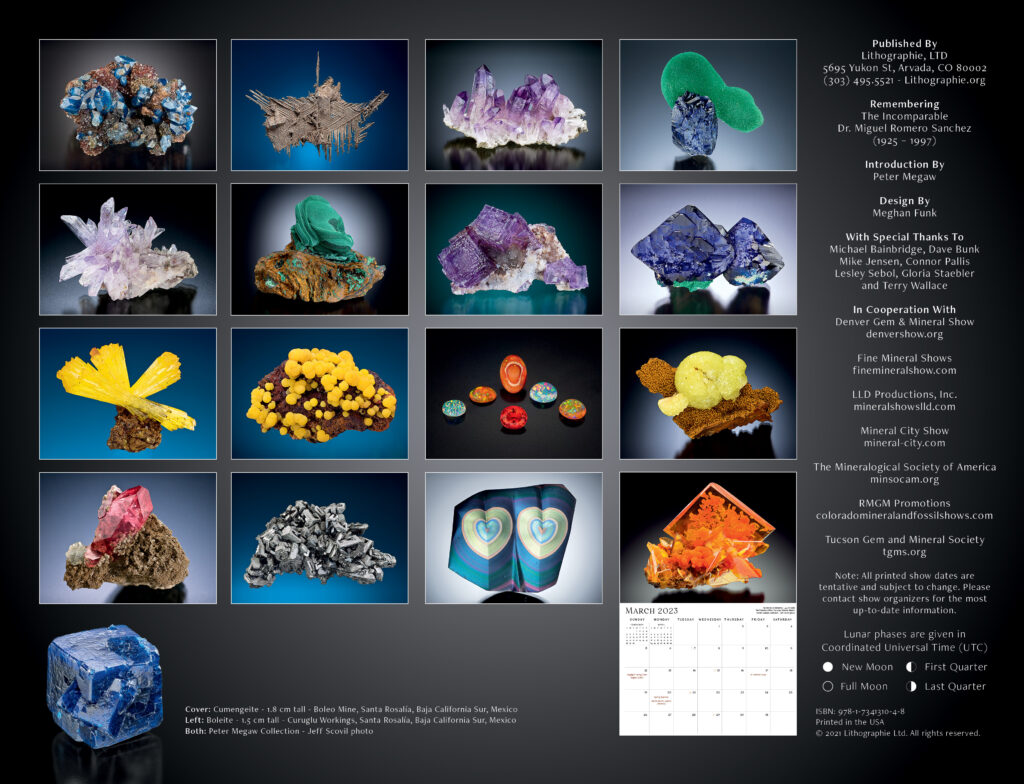2022 Calendar: Minerals of Mexico, a 13-month calendar.
Author: Meghan FunkPeter Megaw
From the Lithographie website:
Boasting a mineralogical richness that almost matches her vibrant culture, Mexico is endowed with specimen localities that have yielded a spectrum of exceptionally well-developed minerals, common and rare. Home to nearly 80 type-species, Mexico is striped from north to south, west to east, and top to bottom with world-class specimen occurrences; many of these are found in the mines that underpin her economy, history, and cultural evolution. Separating Mexico from her mining and mineralogical heritage would be, as they say in Mexico como tacos sin tortillas, “like tacos without tortillas.”
From north to south, Mexico’s mineralogy mirrors the “Pacific Ring of Fire,” the belt of volcanoes and intrusions that developed above the subduction zone that once ran uninterrupted along the west coast from the United States to Guatemala. The giant volcanoes and the magma chambers beneath their summits gave us a dazzling array of minerals: from opals to apatites, gold nuggets to agates — treasures that have been prized for centuries. Metallic ore deposits related to those intrusions have yielded more than 25 percent of all of the silver mined in human history — miners have been bringing home important specimens like the “blood of the bull” (pyrargyrite), along with amethyst and calcite, from these deposits for 500 years! Moving from west to east, vein deposits give way to replacement and basin-brine ore deposits; products of gradual changes in magma chemistry and radical changes of host rocks with distance from the subduction zone. The ubiquitous amethyst and calcite are joined here by garnets, fluorites, creedites, pink apophyllites, rhodochrosites, datolites, and danburites.
Ultimately however, because much of Mexico has been geologically stable for eons, top to bottom may be the most important bearing for lovers of Los Colores, Mexico’s brightly colored and well-crystallized oxide minerals. This stability has allowed surface waters to penetrate deeply and convert those silver-rich primary metallic ores to a rainbow of secondary species — many, the best in the world. From these oxidation zones sprang the reds, oranges, and yellows of Mexico’s famous wulfenites, mimetites, and vanadinites; the deep blues and greens of her azurites, malachites, and brochantites; and the lighter blues to purples of her aurichalcites, smithsonites, and adamites.
As prevalent as this panoply of colorful species are in our collections, let’s not forget the products of a truly unbridled Nature manifested in the world’s first true international mineral celebrities — the 14-meter-long transparent gypsum behemoths of Naica’s Cave of the Crystals — that none of us will ever see in captivity!
The calendar is published by Lithographie, LLC in cooperation with Denver Area Gem & Mineral Show, Fine Mineral Shows, LLD Productions, Inc., The Mineralogical Society of America, RMGM Promotions, and Tucson Gem and Mineral Society


